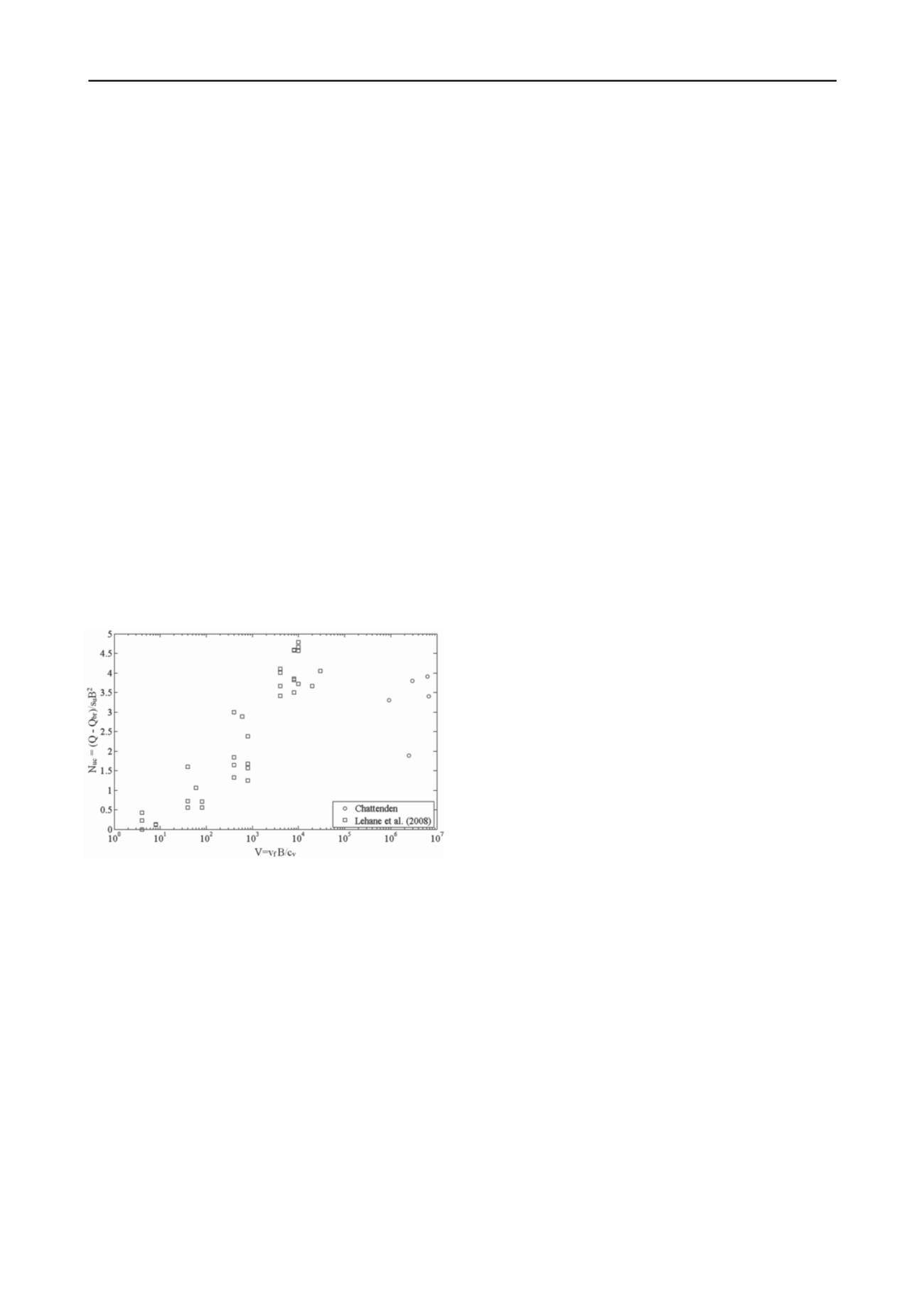
2794
Proceedings of the 18
th
International Conference on Soil Mechanics and Geotechnical Engineering, Paris 2013
3.2
Suction
In previous studies (e.g. Lehane et al. 2008) the degree of uplift
capacity enhancement may be estimated as the difference
between the suction and breakaway uplift resistances (Eq. 3).
When the uplift capacities are evaluated using the slope method
(BSI 1997) the average enhancement due to suction is 325 kN.
This is equivalent to a pore water pressure drop of 155 kPa from
hydrostatic. The magnitude of pore water pressure drop is
similar to the values of pore water pressure measurements
observed during undrained uplift of model footings (Lehane et
al. 2008).
5 ACKNOWLEDGMENTS
The authors wish to thank National Grid UK for the financial
support required to conduct the field tests. The authors
gratefully acknowledge the work of Grid Line Foundations Ltd,
Andrew Hewitt of Lankelma and PMC.
6 REFERENCES
BSI 1997.
Overhead lines - Testing of foundations for structures, BS EN
61773:1997
, London.
N
uc
= (Q – Q
br
)/s
u
B
2
(3)
The effects of suction may be presented using a normalised
velocity (V = v
f
B/c
v
) where c
v
is the coefficient of consolidation
of the underlying London clay (0.24, Skempton and Henkel
1957). The results from Lehane et al. (2008) are presented in
this manner against the undrained bearing coefficient N
uc
. Q
br
was defined as the average uplift capacity values for second
tests on Footing 3 and 4 using the slope method with Q the
uplift resistance of the remainder.
Butcher, A.P. et al. 2009. Comparison of behaviour of CFA piles in
London clay as determined by static, dynamic and rapid testing
methods. In
5th International Symposium on Deep Foundations on
Bored and Auger Piles
. London, 205–212.
Depart of Transport, 2009.
MCHW Volume 1 SHW: Roads pavements -
Unbound cement and other hydraulically bound mixtures
. London
IEEE, 2001
Guide for transmission structures: Foundation design and
testing, IEEE Std 691-2001
, New York.
Lehane, B.M., Gaudine C., Richards, D.J. and Rattley, M.J. 2008. Rate
effects on the vertical uplift capacity of footings founded in clay.
Géotechnique
58(1), 13–21.
Merifield, R.S. and Sloan, S.W. 2006. The ultimate pullout capacity of
anchors in frictional soil.
Canadian Geotechnical Journal
43(8),
852–868.
Figure 5. shows the similarity between the results of the
model tests at v
f
= 30 mm/s and the field tests results on London
clay. The range of N
uc
of the tests on London clay is between
3.3 - 3.9 compared to 3.7 – 4.1 for v
f
= 30 mm/s. The data point
at N
uc
= 1.9 corresponds to Test 3-A, which did not reach peak
but evidently mobilised a degree of suction.
Murray, E.J. and Geddes, J.D. 1987. Uplift of anchor plates in sand.
Journal Of Geotechnical Engineering
113(3), 202–215.
National Grid 2004.
Overhead line support foundations, TS 3.4.15 Issue
2
. Warwick, UK.
Rao, N.S. and Datta, M. 2001. A comparison of uplift and bearing
behaviour of plate anchors in soft clay. In
Eleventh International
Symposium Offshore and Polar Engineering Conference
.
Stavanger. 560-565.
Skempton, A.W. and Henkel, D.J. 1957. Tests on London clay from
deep borings at Paddington, Victoria and the South Bank. In
Proceedings of the 4th International Conference on Soil Mechanics
and Foundation Engineering
. London, 100–106.
Figure 5. N
uc
from tests on transmission tower footings
4 CONCLUSIONS
The series of field tests on a number of full scale L4M footings
has confirmed that base suction may contribute significantly to
footing performance. Preliminary analysis has shown that the
magnitude of suction developed is similar to that observed in
physical model tests conducted in a centrifuge.
The results have also shown that the design uplift
performance is not reached (in general) before the ultimate limit
state displacement criterion set by UK design guidance. This
includes the performance of footings were suction developed. In
the case where suctions did not develop, the uplift performance
of the footings was extremely poor. Such a poor performance
will require a re-evaluation of the use coarse granular material,
specifically Type 2, when used in excavations bounded by
London clay.


